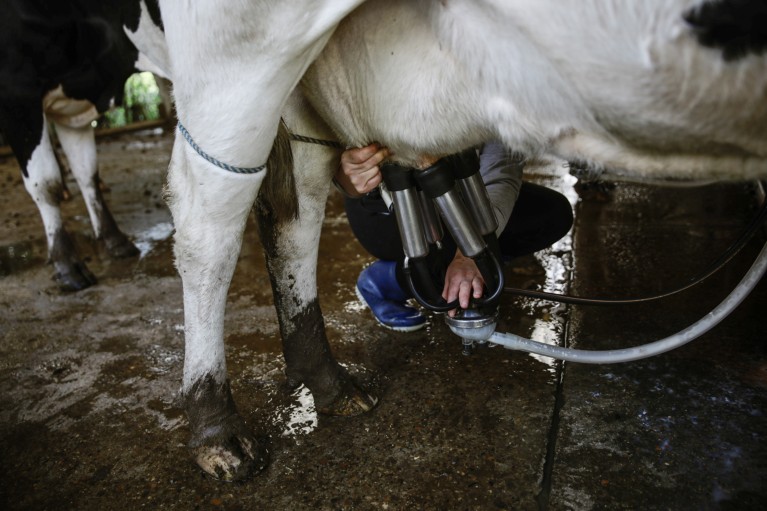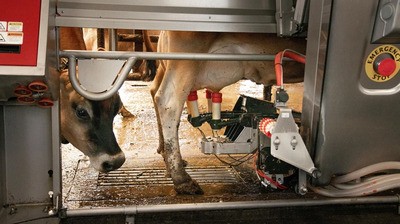Huge amounts of bird-flu virus found in raw milk of infected cows


The H5N1 virus can persist for hours in spattered droplets of milk from infected cows. Credit: Juancho Torres/Anadolu Agency/Getty
Milk from cows infected with bird flu contains astronomical numbers of viral particles, which can survive for hours in splattered milk, new data shows1,2. The research adds to growing evidence that the act of milking has probably been driving viral transmission among cows, other animals and potentially humans.
That’s a better scenario for public health than transmission through airborne particles, which would be more difficult to contain. “It’s good news it’s probably spreading by the milking process,” says Martin Beer, a virologist at the Federal Research Institute for Animal Health in Greifswald, Germany. This means that changes to milking procedures could help to bring the outbreak under control and prevent human infections.
A virus that’s going places
Since it was first isolated in 19963, the highly pathogenic bird-flu virus H5N1 has caused outbreaks in domestic and wild birds around the world, and it has occasionally infected mammals such as seals and foxes. On 25 March, US health officials announced that H5N1 had been detected in dairy cows for the first time. As of 5 June, infections have been confirmed in more than 80 dairy herds in nine states and in three dairy farm workers, all of whom had mild symptoms.
Scientists had not previously suspected that cattle could easily become infected with bird flu, because the animals were thought to lack the receptor allowing the virus to enter their cells. But reports of sick cattle with inflamed udders raised suspicions that the virus can infect the animals’ mammary glands.
New studies4,5 support this idea, showing that cells lining cows’ milk glands have abundant receptors for H5N1 and that this bird-flu strain proliferates in these cells rather than in the respiratory tract, which influenza viruses usually infect. “The mammary glands seem to be the main target of viral replication,” says Diego Diel, a virologist at Cornell University in Ithaca, New York, who co-authored one of the studies. But some infected cows also experience mild respiratory symptoms, Diel and his colleagues report.
The studies were posted on the preprint server bioRxiv and have not yet been peer reviewed.
Viral milkshake
Diel and his colleagues examined the milk of cows with H5N1 and found astonishing amounts of virus: some samples contained hundreds of millions of infectious particles, a level “that is higher than we can grow in the lab” for experiments, says Seema Lakdawala, an influenza virologist at Emory University School of Medicine in Atlanta, Georgia. “In ideal conditions, we don’t get that — this is crazy high.”
Bird flu virus has been spreading among US cows for months, RNA reveals
This abundance could help to explain why H5N1 viral fragments have been found in one in five retail milk samples6: a small number of infected cows could taint the milk supply with many particles. (Pasteurization inactivates H5N1 in milk, according to a preprint7 posted last week.)
Beer sees opportunity in the sky-high numbers of infectious virus particles in milk. It means that testing milk pooled from all of a farm’s cows is likely to reveal the presence of even a few infected ones, and this is easier than testing individual animals. Pooled testing could inform workers on when to be on the lookout for sick animals, which could then be isolated.
Spilt milk
The findings suggest that minimizing exposure to raw milk could be an important way to prevent transmission. But the enormous scale of US milking operations means that stopping the spread will be complicated, says Juergen Richt, a veterinary virologist at Kansas State University in Manhattan.
To begin with, the same milking equipment is used on many cows, offering the virus ample opportunity to spread. And milking is messy. Milk often spills onto the floor, and when equipment that suctions to cows’ udders is released, the liquid sprays out in every direction. This endangers dairy workers, Lakdawala adds. “That isn’t normally a big deal for people who work there — they’re used to it — but that means they’re bombarded with virus.”
US will vaccinate birds against avian flu for first time — what researchers think
Data collected by Lakdawala and her colleagues support her worries: infectious virus can persist in milk droplets and on milking machines for hours, they found. On the basis of these data, she urges farms to consider disinfecting equipment between uses, installing proper ventilation and offering protective equipment, such as face shields, to farm workers to prevent further spread.
To complicate matters, lactating cows — infected or not — must be milked regularly to avoid serious injury to the animal. That means that dairy farms, which typically send raw milk to large-scale facilities for processing, need money and equipment to inactivate the virus in milk from infected cows. Otherwise, it might be dumped it in a place where other animals, such as farm cats, could encounter it, Lakdawala says.
Richt and his colleagues are collecting data to determine whether non-lactating cows and male cattle are also susceptible to the virus, but for now, he says that focusing on milking can help to control the outbreak.










